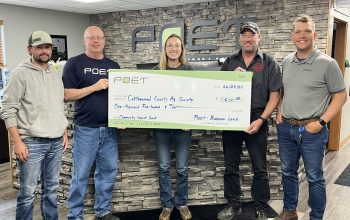After a hiatus last year as a result of COVID, the Wright County Farm Bureau and the Wright County ISU Extension office were excited to once again be able to host their annual Safety Day event at the Wright County Fairgrounds in Eagle Grove this past Thursday, Sept. 9.
It was the perfect day for Wright County third graders to learn all about safety in nine different sessions. Of course by third grade, many students have heard from their parents and teachers the importance of being careful around water, farm equipment, electricity, fire, bad weather, etc., but this free program helps take those lessons one step further, even offering some hands-on activities to help explain a little better. In addition, we all know that sometimes children just listen better to the cautions of other people – like teachers, doctors, and other professionals, which is precisely why Farm Bureau and Wright County Extension have been working together for more than a decade to offer the Safety Day Program for area third graders.
The event was once again hosted at Greenwood Park. Students from Clarion-Goldfield-Dows, and Belmond spent the day learning about water safety, electrical safety, lawn mower safety, first aid, fire prevention and safety, chemical and farm safety, weather warnings/alerts and how to react and take cover, and how to get out of a smoke-filled room. They were also able to learn what it is that EMS workers do and how they and the rest of the ambulance crew can help you in times of emergencies. Students from Eagle Grove were not present this year due to illness.
Year-after-year, the EMS station proves to be one of the most interesting sessions for the kids, engaging them by selecting one member from each group to place on the gurney. As the student volunteer is strapped in, the Belmond ambulance crew talk to the kids about what they would do to help a patient in a real emergency and how it is important for kids to answer honestly all of the questions they are asked by the EMTs. They also explained to the kids what several pieces of equipment were used for in the ambulance – like an oxygen hose, a stethoscope, a neck brace, and somewhat new in their service, a EVAC-U-Splint that replaced the hard backboard they use to place patients on to get to the cot. This is a softer version that can then be deflated, tightening up around the patient to keep them both stable and comfortable.
The firefighters station is also a popular session. They talked to the kids about important things they need to do for themselves if they are in need of help and are waiting for a firefighter – stay low to the ground, don’t hide, when they hear the fire fighter you need to call out for help so they can find you. Unlike many fire fighting TV shows and movies portray, it is nearly impossible for firemen to see once they are inside a smoke or fire filled building so they depend on sound and feel to get them through. That’s why the firemen also reminded students to never, ever go back inside a fire once they are out in order to save a pet or their favorite toy. Students also learned that a fireman’s gear weighs approximately 50 pounds, but when firemen put it on for an emergency, they can do it in about 60 seconds. After learning about what a firefighter will look like and what they will say when they come into a burning building to look for you, the kids also got to see what it looks like when a stream of powerful water comes streaming out of their big fire hose.
The kids also found it interesting to talk about how a fire spreads, including the fact that oxygen feeds a fire. Another important fact they learned – it’s better to sleep with your bedroom door shut to create a barrier should a fire start outside your room while you are sleeping. One other piece of information the firemen told the students – remember, it’s important to know your address so they can save you if you need help.
Addresses were also talked about in the Smoke Room and Safe Exit room. In this session, kids had to crawl to the window in order to climb out of a smoke-filled (simulated) room, Stop-Drop-and Roll, and then go to the closest telephone and dial 9-1-1 to give the operator the necessary information needed to get the fire trucks and other emergency units there to help. One piece of advice for adults – if you have a landline, make sure your children know how to use it. So many kids today are used to using cell phones, that unless they’re taught, they’re not really sure how a “normal” phone works. Also, make sure you have not just one, but two safety routes and meeting places your kids know to go to – and don’t forget to practice it.
Basic first aid was another session. Did you know if you have a bloody nose, never shove a tissue up it and then tip your head back. Instead, the best way to stop it is to pinch the nose right below the bone – at the top of the nose – for 10 minutes. Tilt your head forward. You can also put ice on it. If it still doesn’t stop, go to the doctor. Hint – when it finally stops bleeding, resist the urge to pick the inside of your nose. What you’re feeling are the blood clots and if you pick them out, your nose will likely start bleeding again. Thanks to grants from Wright County Charitable Foundation and Iowa’s Center for Agricultural Safety and Health (I-CASH), each student also received a first aid kit to take home.
Students were also taught how to make a homemade sling should they hurt their arm. It’s simple, but very effective until you can get to the doctor’s office. Take a T-shirt, put your head through it – but not your arms. Instead, take the injured arm and place it in the opposite arm hole. This will create an instant sling to protect the injury. Genius really! The old schoolhouse building is always the place where kids learn about chemical and farm safety. They discussed how you should never eat or drink anything that is not in its original container (and adults should never keep chemicals out of their original packaging) because it could be dangerous. For example – blue Gatorade looks exactly like antifreeze. Apple juice looks just like Pinesol, but they certainly don’t taste the same, and one will obviously make you very sick.
The leader told the kids that if they did accidentally inhale or ingest a chemical, the first thing they should do is tell an adult so they can get the appropriate help they need.
The dangers of electricity can be tricky to understand for third graders – talking about conductors and insulators. That’s why representatives of Prairie Energy Cooperative were on-hand to talk with the kids. The thing that seemed to get the kids’ attention the most was when they were shown a hot dog and told it’s made up of 60 – 70 percent water, just like a human being. When the professional touched the hot dog to live wire, the kids’ eyes grew huge when they saw how the wire “cooked” the hot dog. They also learned that dead critters on a transformer can cause a power outage, and if you are ever in an accident involving a vehicle and a live wire pole, don’t just get out of your car. You could become an electricity conductor and get electrocuted. Instead, open the door, hop out landing on two feet, and then continue to “bunny hop” so both feet are up or down at the same time, until you're at least 20 feet away from the vehicle to best ensure your safety from an electrical shock.
For the adults, a reminder to always call before you dig. Be safe! 1-800-292-8989.
With summer quickly coming to an end, water safety with the Wright County Conservation office seemed a very appropriate session. Many of the kids throughout the summer participated in some type of water activity whether it was swimming, boating, or something else. In this session they talked about simple tips like the importance of wearing the right size life jacket, kayaking safety, and more.
The weather alerts station was also popular with the kids. After a brief introduction about what tornadoes are, how they occur, and what to do to stay safe, the trailer began to shake. Then the lights went out. Then you could hear the wind ripping through. It was simulating a tornado, but the children were told before it would all happen and that they were in a safe, controlled environment. After the simulation was over, it was explained to the kids how important it is to try and remain as calm as possible – so as to not scare other siblings; so they could hear directions being given to them; and so that they could make smart choices.
This Safety Day was made possible by grants from the Wright County Charitable Foundation and local sponsors including: Bayer, Corn, LP, First Citizens Bank (Clarion), Gold Eagle Cooperative, GrowMark FS, Hagie Manufacturing Co., Iowa Specialty Clinics, MaxYield Cooperative, Prairie Energy Cooperative, Wright County Fair, Wright County Farm Bureau, and Wright County ISU Extension. Each student received a T-shirt as well.


